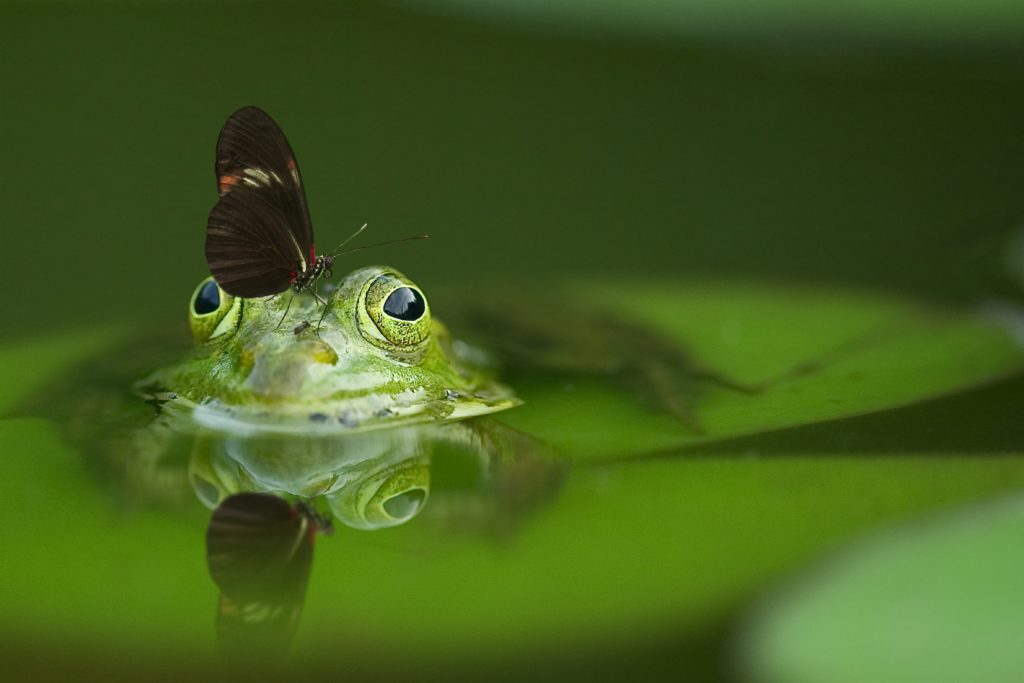It’s Earth Day this Friday, April 22. To celebrate Earth Week, here are five of our animal friends whose lives will be improved by the measures we take to curb our negative impact on the natural world:
Frogs

As amphibians, frogs can exist both in and out of water, and they have very thin skin, not metaphorically, but literally! They are often some of the first creatures to exhibit mutations if something in their environment is out of balance. These elegant but fragile creatures play an important role in the ecosystem. They control the insect population, and they also act as a food source to larger animals. Frogs exist in wet habitats, and they breath not only with their lungs but through their skin. Chemicals ranging from pesticides to detergents can all enter the water in which they live, impacting their health. Reducing unnecessary use of chemicals will reduce water pollution and help these animals to thrive.
Polar bears

These bears have become the poster child for climate change. Their habitat has been shrinking steadily due to melting ice caps, which has been attributed to an increase in temperatures globally. As the largest land-based carnivore, polar bears exist at the top of the food chain. Although they are great swimmers, they still rely on the ice mass for travel and hunting. The Arctic is warming twice as fast as the global average, which affects not only polar bears, but their primary food source, seals. We have an opportunity to reverse our greenhouse gas emissions, slow this warming trend and save these crucial members of the ecosystem.
Coral
Coral species range in the thousands, and play a critical role in ocean ecology. Although they could easily be mistaken for a type of plant, they are in fact tiny animals. They exist in colonies and live in symbiosis with algae. Their little limestone exoskeletons form the building blocks of the larger structures we interpret as individual pieces of coral. Coral reefs include hundreds or more different species, and provide a home for many other sea creatures. Given their position near the bottom of the food chain, and their reliance on algae (also at the bottom), they are particularly susceptible to runoff from land pollution. There are many things you can do to lessen this type of pollution. Reduce your use of fertilizers and pesticides, use chemical free sunblocks, don’t dump chemicals into sewer drains, and pick up after your dog (use a newspaper or reusable scooper in lieu of plastic bags).
Birds
Did you know that birds are often affected by the same air quality concerns as humans? Small migratory birds make up 86% of all land bird species in North America. These include sparrows, warblers and finches. These birds experience many of the same respiratory problems that we humans do if the air is polluted. That same pollution also affects their food sources. The good news is that many of the measures we have already taken to improve air quality for ourselves has incidentally also helped birds. It is estimated that around 1.5 billion birds may have been saved in the last 40 years due to reduced ozone emissions. This encouraging statistic tells us that our efforts do make a difference.
Humans
This is a bit of a bait and switch, but it bears saying that we do ourselves a great service by taking our collective well-being into account in our daily lives. Changes in the environment affect all of these animals, and we are no different. We are only as healthy as the food we eat, the water we drink and the air we breathe. It’s easy to see the environment as a place we need to keep healthy for animals and plants, for the beauty of national parks, or for the benefit of our leisure time outdoors. But we should see ourselves as one and the same with our environment. Just like all the animals above, we thrive when we have the resources we need, in quantity and quality. It’s not just for the animals, or the next generation of humans – it’s for all of us, here and now.
As an Amazon Associate, this site may contains affiliate links and I can earn from qualifying purchases at no cost to you. View disclosure for more information.
I'm Claudia. Welcome to my Interior Design blog! I'm thrilled to share my expertise and passion with you. With over 20 years in the industry, I'm a Certified Interior Designer, holding an NCIDQ Certification, and an educator. Interior Design isn't just my career—it's my passion. Dive in to explore more about me. Click here to learn more!
Hi Friend!
Stay inspired—join our design community by subscribing to the blog today.
subscribe now
Other Posts You Might Like
©2025 Claudia Giselle Design | Interior Designer | Brooklyn, New York
Legal
BACK TO TOP
Testimonials
718-255-5949
Press
office@claudiagiselle.com
MENU
We create thoughtful, personalized interiors for those who value quality and beauty in every detail — serving NYC, Manhattan, Brooklyn, Long Island, the Hamptons, and the Hudson Valley (including Westchester and Dutchess County) & Beyond.
Timeless Classicism with a
Bold Touch of Elegance
Home
Services
Process
About
Blog
Portfolio
Scheudule a Consultation
GET IN TOUCH
Contact





